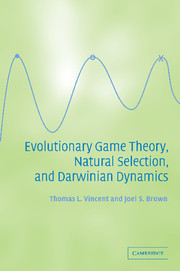Book contents
- Frontmatter
- Contents
- List of figures
- Preface
- 1 Understanding natural selection
- 2 Underlying mathematics and philosophy
- 3 The Darwinian game
- 4 G-functions for the Darwinian game
- 5 Darwinian dynamics
- 6 Evolutionarily stable strategies
- 7 The ESS maximum principle
- 8 Speciation and extinction
- 9 Matrix games
- 10 Evolutionary ecology
- 11 Managing evolving systems
- References
- Index
6 - Evolutionarily stable strategies
Published online by Cambridge University Press: 11 August 2009
- Frontmatter
- Contents
- List of figures
- Preface
- 1 Understanding natural selection
- 2 Underlying mathematics and philosophy
- 3 The Darwinian game
- 4 G-functions for the Darwinian game
- 5 Darwinian dynamics
- 6 Evolutionarily stable strategies
- 7 The ESS maximum principle
- 8 Speciation and extinction
- 9 Matrix games
- 10 Evolutionary ecology
- 11 Managing evolving systems
- References
- Index
Summary
Natural selection produces strategies that are continually better than those discarded along the way to some evolutionary equilibrium. Intuitively this implies that eventually, natural selection should produce the “best” strategy for a given situation. The flowering time of a plant, the leg length of a coyote, or the filter feeding system of a clam should produce higher fitness than alternative strategies that are evolutionarily feasible (within the genetic, developmental, and physical constraints in the bauplan). In graphical form these products of natural selection should reside on peaks of the adaptive landscape. Yet we have seen in the previous chapter how, under Darwinian dynamics, natural selection may produce strategies that evolve to minimum points, maximum points, and saddlepoints on the adaptive landscape.
An evolutionary ecologist studying the traits of a species whose strategy has evolved to a convergent stable minimum on the adaptive landscape may, on reflection, be surprised. At this minimum, any individual with a strategy that deviates slightly from that produced by Darwinian dynamics has a higher, not lower, fitness than the resident strategy. While an evolutionarily stable minimum can result from Darwinian dynamics, this strategy is not the “correct” solution to the evolutionary game. In this chapter, we expand upon the original word definition of an evolutionarily stable strategy (ESS) as given by Maynard Smith: “An ESS is a strategy such that, if all members of a population adopt it, then no mutant strategy could invade the population under the influence of natural selection” (Maynard Smith, 1974).
Information
- Type
- Chapter
- Information
- Publisher: Cambridge University PressPrint publication year: 2005
